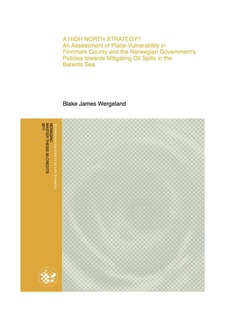| dc.description.abstract | The objective of this thesis project is to determine how the Norwegian Government aims to mitigate Place-Vulnerability in Finnmark County, Norway from the risk of oil spills imposed by increasing volumes of maritime traffic along the Finnmark Coast in the Barents Sea – as part of its High North Strategy. This project reaches this objective by conducting a quantitative analysis of Place-Vulnerability within Finnmark County to determine where and why certain geographical regions are vulnerable. To complete the Place-Vulnerability
analysis, separate assessments of Social Vulnerability and Biophysical/Technological
Vulnerability towards shipping hazards were conducted utilizing the Hazards-of-Place
framework for Place-Vulnerability. Once completed, the results from these individual
assessments were combined and analyzed to present an overall depiction of Place-
Vulnerability within the county. A subsequent qualitative inquiry was conducted to identify specific policies and practices aimed to reduce the risks of oil spills along the Finnmark Coast, adopted by the Norwegian Government as part of its High North Strategy over the past
decade, and ultimately to estimate whether or not these measures are sufficient towards
protecting the Finnmark Coast and mitigating the determined Place-Vulnerability values. The results of the Place-Vulnerability assessment demonstrate that all municipalities within Finnmark County are vulnerable to the adverse socio-economic and ecological consequences
of oil spills in its coastal waters. However, by delineating the county into three separate
geographical regions, or Blocks, this project was subsequently able to determine and
compare Place-Vulnerability among and across these regions. The results depict that the western municipalities (Block 3) of Finnmark County are attributed with the highest levels of Social Vulnerability, and that the coastal waters here are additionally the most hazardous towards maritime transport operations. This Block therefore has the highest overall level of
Place-Vulnerability. Eastern Finnmark (Block 1) had the lowest levels of Social
Vulnerability, but is particularly vulnerable towards shipping hazards, thus resulting in the second highest levels of overall Place-Vulnerability. Central Finnmark (Block 2) was attributed to have the lowest level of vulnerability towards shipping hazards, but the second highest level of Social Vulnerability, which resulted in carrying the lowest level of overall Place-Vulnerability within Finnmark County. In addition to the Place-Vulnerability analysis, an inquiry into the adopted measures of the
Norwegian Government towards reducing maritime shipping accidents and subsequent oil spills was conducted. This research highlights that the Norwegian Government has focused primarily on five priority policy areas to reduce shipping accidents along the Finnmark Coast: An Ecosystem-Based Management Regime within the Barents Sea; New maritime vessel traffic standards, requirements, and surveillance; Increased oil spill preparedness and response systems; Advanced cooperation with Russia in the Barents Sea; and support for the
creation and implementation of an IMO Polar Code. Combined, these measures demonstrate a risk reducing effect towards shipping accidents. Ultimately, however, it is estimated that these measures are only sufficient to meet the protection needs of the vulnerable Finnmark Coast at the current volume of maritime traffic. Maritime Traffic in the Barents Sea is
projected to increase by approximately five-times the current level by the year 2020.
Therefore, additional measures such as further increasing the capacity of emergency
response vessels and available equipment, in addition to adopting more stringent vessel
certification regulations must be a priority area of the Norwegian Government to combat the increasing risks of oil spills directly correlated to the projected 2020 levels of maritime traffic. | no_NO |
